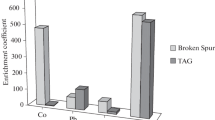Abstract
The formation of significant amounts of thiosulfate ion (up to 42 mg/L) was established in experiments on the interaction of sulfide-bearing rocks with water. The possibility of the formation of palladium compounds with thiosulfate ion [Pd(S2O3)2]2– was demonstrated. The stability constant of the complex is 3.7 × 109, which may provide intense migration of this palladium species in ecosystem. The study of the behavior of palladium thiosulfates during interaction with inorganic and organic components of geochemical barriers showed that around 50–55% of thiosulfate-bound palladium is extracted by humic acid in the pH range typical of natural waters. Under these conditions, ferrihydrite sorbes palladium quantitatively, and may serve as efficient barrier to the interaction of palladium compounds with particulate matters of waters and bottom sediments.
Similar content being viewed by others
References
E. Y. Anthony and P. A. Williams, “Thiosulfate complexing of platinum group elements. Implications for supergene geochemistry,” in Environmental Geochemistry of Sulfide Oxidation, Ed. by C. Alpers, et al. (ACS Symposium Series, American Chemical Society, Washington, 1993), pp. 551–560.
M. G. Aylmore and D. M. Muir, “Thiosulfate leaching of gold (a review),” Mineral. Eng. 14 (2), 135–174 (2001).
R. M. Fitz and H. Cypionka, “Formation of thiosulfate and trithionate during sulfite reduction by washed cells of Desulfovibrio desulfuricans,” Arch. Microbiol. 154, 400–406 (1990).
J. L. Jambor and J. E. Dutrizac, “Occurrence and constitution of natural and synthetic ferrihydrite. A widespread iron oxyhydroxide,” Chem. Rev. 98, 2549–2585 (1998).
I. V. Kubrakova, A. V. Fortygin, S. G. Lobov, I. Ya. Koshcheeva, O. A. Tyutyunnik, and M. V. Mironenko, “Migration of platinum, palladium, and gold in the water systems of platinum deposits,” Geochem. Int. 49 (11), 1072–1084 (2011a).
I. V. Kubrakova, A. V. Nikulin, I. Ya. Koshcheeva, and O. A. Tyutyunnik, “Platinum metals in the environment: content, determination, and behavior in natural systems,” Khim. Interesakh Ust. Razvitiya 20, 645–656 (2012).
I. V. Kubrakova, D. V. Pryazhnikov, I. Ya. Koshcheeva, O. A. Tyutyunnik, N. V. Korsakova, D. N. Chkhetiya, and L. V. Krigman, “Formation and migration behavior of gold (I) thiosulfate in aqueous systems of gold deposits (experimental studies),” Vestn. Otd. Nauk Zemla Ross. Akad. Nauk 3, (2011á), NZ6059. doi10.2205/2011 NZ000189
I. V. Kubrakova, G. M. Varshal, Yu. F. Pogrebnyak, and T. F. Kudinova, “Speciation of platinum and palladium migration in natural waters,” in Chemical Analysis of Marine Sediments, Ed. by E. A. Ostroumov (Nauka, Moscow, 1988), pp. 104–119 [in Russian].
B. W. Mountain and S. A. Wood, “Chemical controls the solubility, transport, and deposition of platinum and palladium in hydrothermal solutions: a thermodynamic approach,” Econ. Geol. 83, 492–510 (1998).
N. A. Polotnyanko and I. L. Khodakovsky, “Solubility of palladium oxide and hydroxide at 25°C,” Vestn. Otd. Nauk Zemla Ross. Akad. Nauk, 4, NZ9001 (2012). doi 10.2205/2012NZ_ASEMPG
T. Rohwerder, T. Gehrke, K. Kinzler, and W. Sand, “Bioleaching review part A: progress in bioleaching: fundamentals and mechanisms of bacterial metal sulfide oxidation,” Appl. Microbiol. Biotechnol. 63, 239–248 (2003).
A. Schippers, T. Rohwerder, and W. Sand, “Intermediary sulfur compounds in pyrite oxidation: implications for bioleaching and biodepyritization of coal,” Appl. Microbiol. Biotechnol. 52, 104–110 (1999).
J. M. van Middlesworth and S. A. Wood, “The stability of palladium(II) hydroxide and hydroxy-chloride complexes: an experimental solubility study at 25–85°C and 1 bar,” Geochim. Cosmochim. Acta 63 (11–12), 1751–1765 (1999).
G. M. Varshal, T. K. Velyukhanova, I. Ya. Koshcheeva, I. V. Kubrakova, and N. N. Baranova, “Complexation of noble metals with fulvic acids of natural waters and geochemical role of these processes,” in Analytical Chemistry of Trace Elements, Ed. by A. N. Ermakov, B. F. Myasoedova, E. K. Korchemnaya, V. A. Ryabukhin, and E. P. Shumilova (Nauka, Moscow, 1988), pp. 112–146.
S. A. Wood, “The aqueous geochemistry of the platinumgroup metals with applications to ore deposits,” in The Geology, Geochemistry, Mineralogy and Mineral Beneficiation of Platinum-group Elements, Ed. by L. J. Cabri, Can. Inst. Mining, Metal. Petrol. Spec. 6, 211–249 (2002).
Author information
Authors and Affiliations
Corresponding author
Additional information
Original Russian Text © O.A. Tyutyunnik, I.V. Kubrakova, D.V. Pryazhnikov, 2016, published in Geokhimiya, 2016, No. 1, pp. 97–104.
Rights and permissions
About this article
Cite this article
Tyutyunnik, O.A., Kubrakova, I.V. & Pryazhnikov, D.V. Formation and sorption behavior of the palladium thiosulfate complexes under natural conditions (model experiments). Geochem. Int. 54, 85–91 (2016). https://doi.org/10.1134/S0016702915110063
Received:
Accepted:
Published:
Issue Date:
DOI: https://doi.org/10.1134/S0016702915110063



